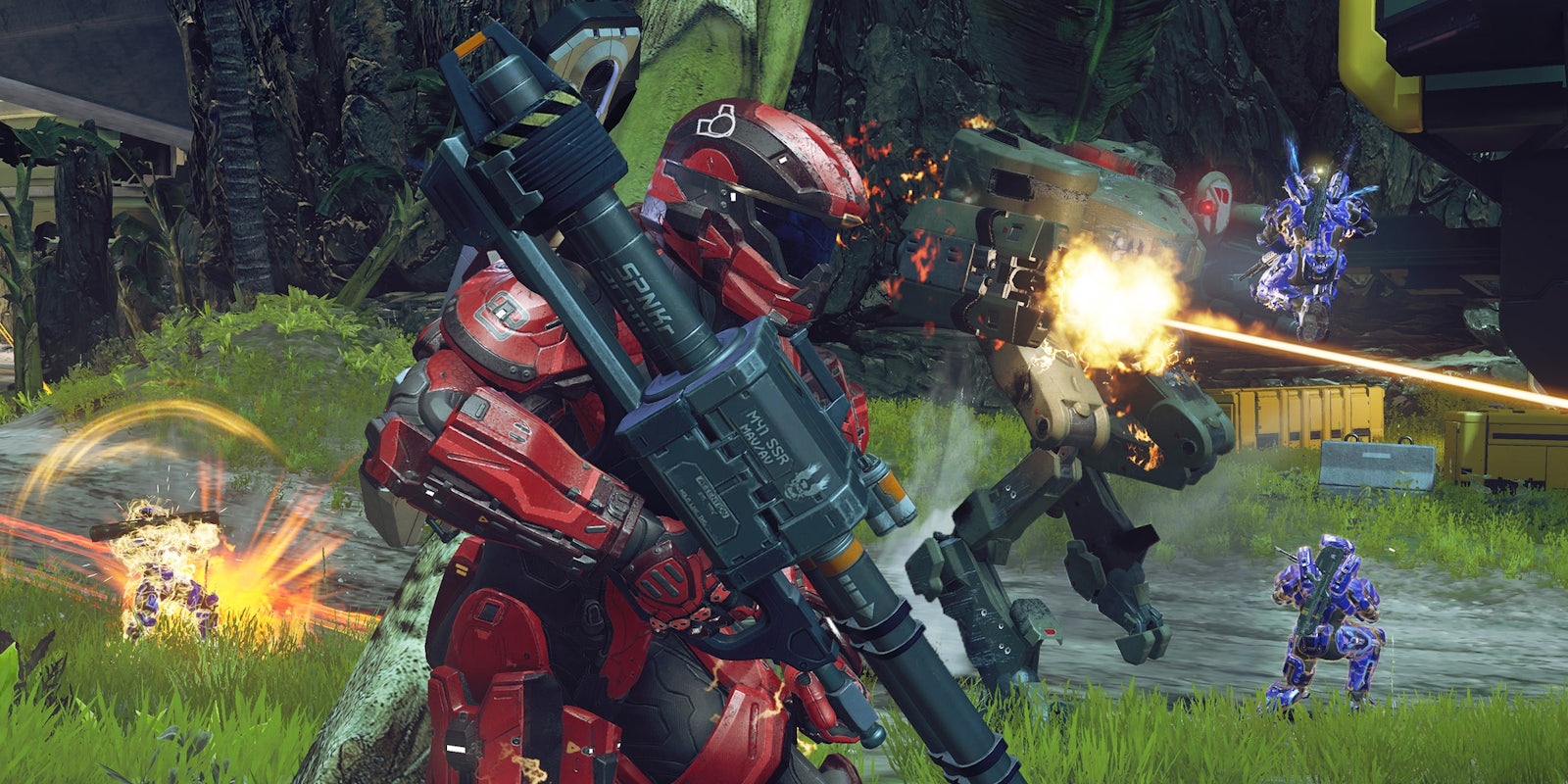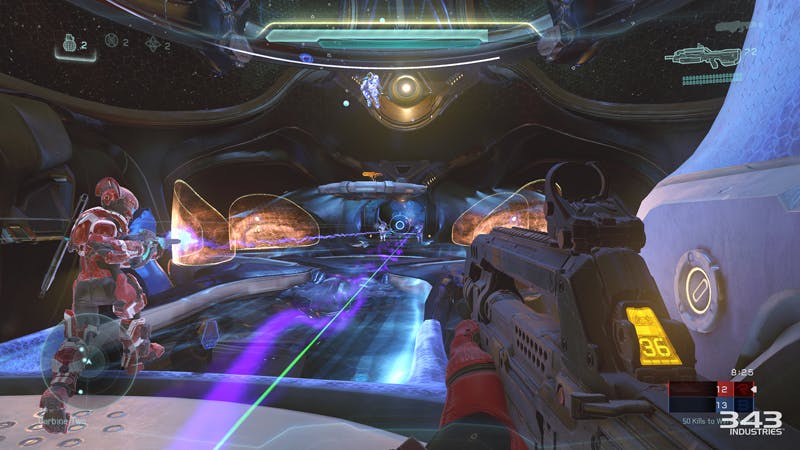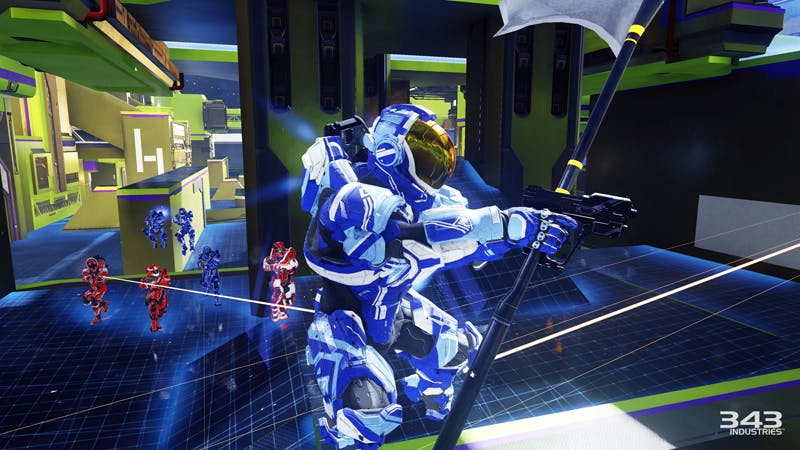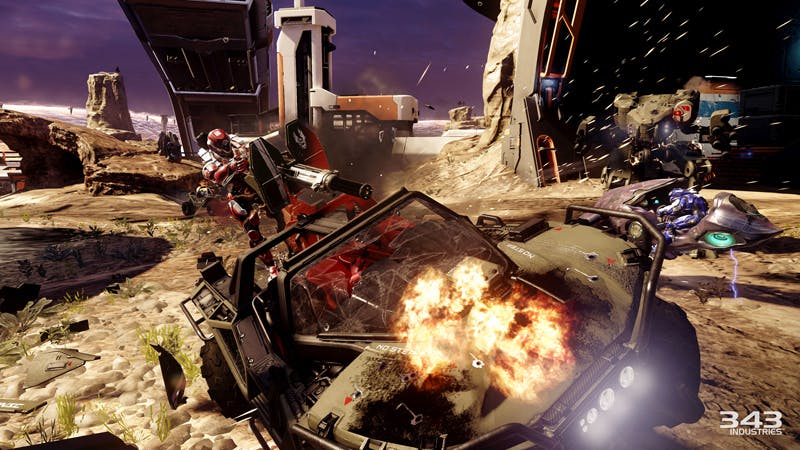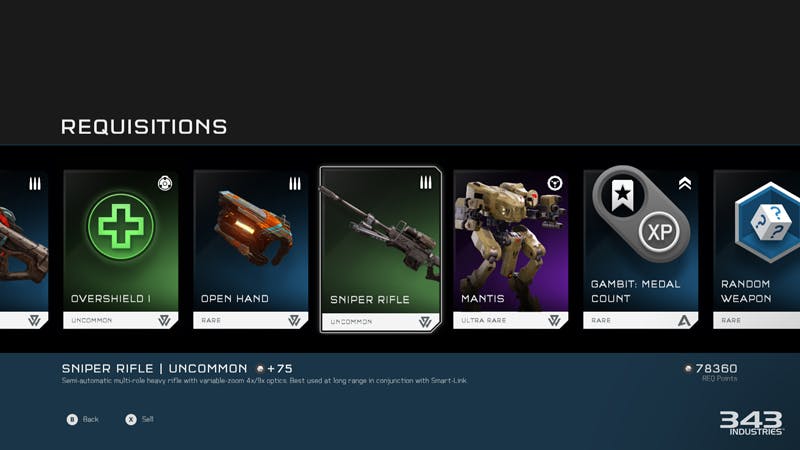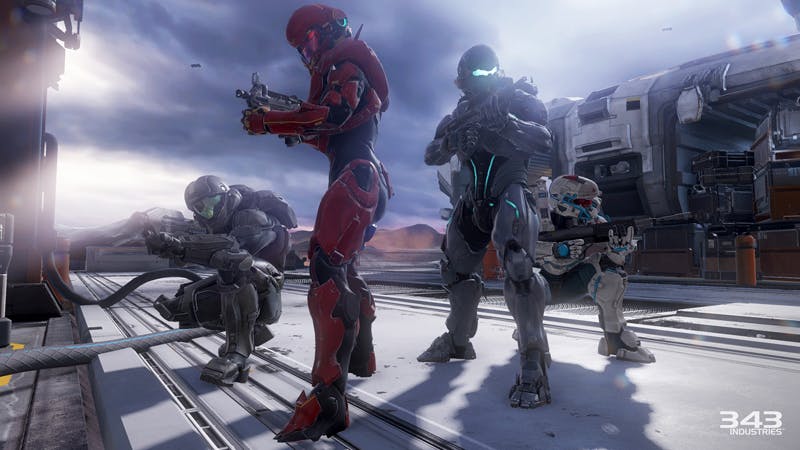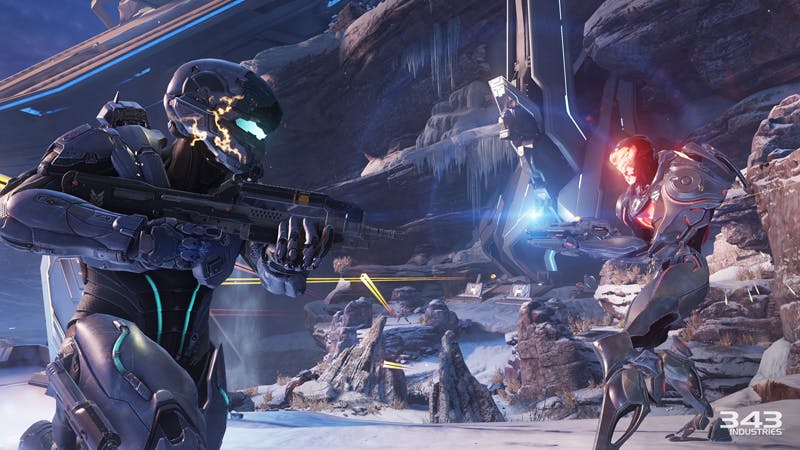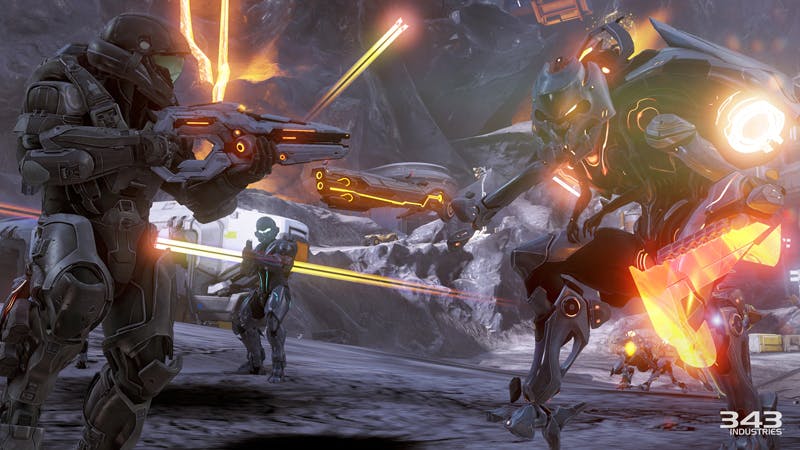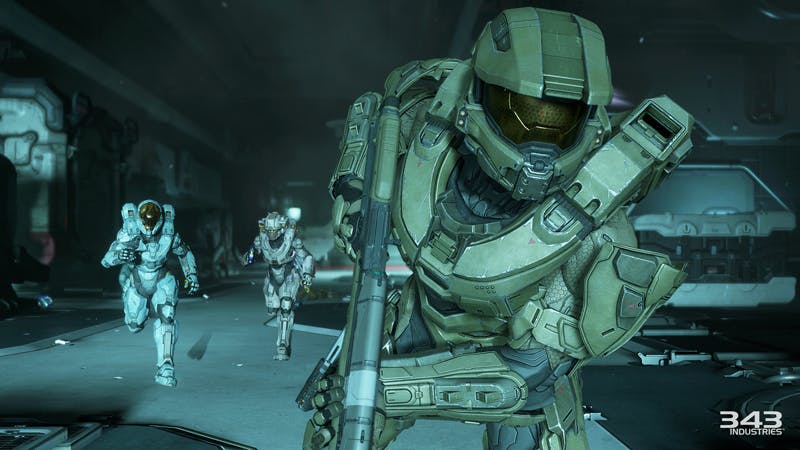If you’re as excited for Halo 5‘s single-player campaign as you are for its multiplayer modes, you’re about to face a conundrum.
The problem for Halo fans who are interested in the whole package is the stark dichotomy between the game’s two halves. Halo 5’s campaign is forgettable. Its multiplayer, on the other hand, is a return to what made Halo 2 and Halo 3 multiplayer so popular.
Halo 5 has become my new touchstone for why we ought to think about reviewing single-player campaigns and multiplayer modes separately.
Conventional wisdom when it comes to big-budget first-person shooters is that the campaign is almost an obligation. The multiplayer is why gamers really care. But that hasn’t historically been the case with the Halo series. Since its debut in 2001, the series has been so compelling it prompted the creation of comic books, novels, animated films, and toys. For some Halo fans the story is the main course and the rest is gravy.
Of course for many it’s still all about the multiplayer. Where Call of Duty depends on custom loadouts, perks, and killstreaks, Halo multiplayer has carried on the legacy of Quake III Arena and Unreal Tournament, focusing on old-school, arena-style multiplayer modes where weapon drops and map control determine victory.
All of our impressions of Halo 5’s multiplayer are based on games hosted on servers that didn’t see traffic anything like what will hit Halo 5 servers on release day.
If the multiplayer portion of Halo 5 is what concerns you most, you are well advised to wait a few days post-release and make sure the game is stable before picking it up.
That being said, the multiplayer was the highlight of our play through. After 343 Industries watered down the brand by adding genre conventions like greater weapons selection and tactical packages in Halo 4, Halo 5 balances the need for the speed and agility of modern-day shooters without compromising the core identity of Halo multiplayer.
Every Spartan has a limited thruster-dash move and a rocket pack that can be used to either hover in the air and launch a powerful ground-pound move or, if you’re running at a sprint, the rocket pack enables a power-melee attack that is extremely satisfying to land as it sends the victim flying across the map.
Melee is still king in general, and grenades still tend to be more important than in other shooters for how liberally ordnance is spread throughout the maps. Everyone in Arena matches begins with the same default weapon loadout, and has to pick up better weapons and ordnance during the match. Halo 5 is, for the most part, a return to classic Halo multiplayer.
Microsoft offered Halo 5 reviewers a pre-release Arena playlist with a sampling of game modes including Slayer, Capture the Flag, a single-flag variant called Breakout that allows no respawns during a round, classic SWAT matches with Battle Rifles only and no radar, and a territory-control mode called Strongholds in which teams may only score points for kills if they control more capture zones than the other team.
Breakout matches went a little too long for me. Each team needs to win five rounds to take the match, and a win is earned either by capturing the flag and returning it to base or eliminating the other team. If a Breakout match goes the full 10 rounds, you may spend a lot of time watching other people from the sidelines when you die while waiting to respawn in the next round.
Strongholds was a really cool variation of typical Domination-type multiplayer modes, which usually have less of a direct connection between holding territory and scoring points. It’s hypothetically possible for a team to control less territory but still win in other Domination-type modes if that team is way out-killing the enemy. You can’t get away with that in Strongholds, however.
In all Arena modes there’s a healthy amount of auto-generated team chatter. Teammates will call out their position if they’re taking fire, and they’ll announce when they pick up weapons, so you’ll know if and when someone picks up a power weapon like a sniper rifle or a rocket launcher. It’s a nice bit of default team communication for anyone who’s playing with randos and doesn’t want to brave the team chat.
Microsoft also offered a limited Warzone playlist for Halo 5 reviewers. Warzone mode is at heart a variant of Big Team Battle from previous Halo games.
The first Warzone variant took place on smaller maps, with one team on offense and one team on defense. The team on offense had to capture two bases and then destroy a power core within the match’s time limit, while the team on defense had to hold them back until the timer ran out. Functionally this smaller variant of Warzone was Rush mode from Battlefield.
The second Warzone variant took place on larger maps, had more bases than the smaller version of the mode, and both teams had a power core to defend. You could only assault the other team’s power core if you controlled all the bases on the map, which was difficult to accomplish while also having enough people to break through enemy defenses around their core.
Destroying the power core is not the absolute victory condition in the larger version of Warzone, however. The match is won by whichever team reaches 1,000 points first. You earn points by killing other players, capturing bases, and also by killing the Covenant and Forerunner troops and bosses that spawn on the map.
Toward the end of some matches a very powerful Forerunner boss spawned that offered enough points for the team in the lead to win if they killed the boss first. That led to awesome, desperate, chaotic firefights where both teams were trying to kill the boss while also killing each other, so as not to let the other team land the killing blow and earn the points.
Warzone mode makes the greatest use of Halo 5’s new multiplayer customization system: the REQ system. Every Arena and Warzone match earns you REQ points. REQ points are spent on REQ packs. REQ packs contain cards that unlock armor customization options, weapon skins, experience boosts, and access to weapons and vehicles in Warzone.
At the beginning of every Warzone match you start by default with one of four weapons in each of two slots. Assault rifles, Battle rifles, SMGs, and Magnum pistols are your options. You cannot hold two of any type of weapon, unless you are wielding a more powerful version of the same gun. For instance, you can equip an Assault Rifle in your first slot, and an Assault Rifle with a laser sight in your second slot.
But you have to earned a REQ card to get access to that Assault Rifle with the laser sight. Any weapon other than the default four choices is only made available to you in the setup for or during a Warzone match if you own the matching REQ card. Even smaller weapons like Needlers and Plasma Pistols and Boltshots require REQ cards.
You need REQ cards to access vehicles, and you may also use REQ cards to boost your speed, your health regeneration, or to give yourself an overshield among other powerups. A REQ card is removed from your collection when you use it, and any benefits earned from a REQ card are lost when you die.
Which REQ cards you can play during a Warzone match depends on your performance. Each REQ card has a REQ level. To play that card, you have to unlocked the corresponding REQ level during the match. You earn points toward unlocking REQ levels through individual accomplishments like killing other players and also by team accomplishments, for instance when your side captures a base.
The REQ system is a mixed bag because every time you spend a REQ card, your available REQ level goes down, and you have to build it back up again. You also tend to unlock higher-level REQs toward the end of the match, and do you really want to spend a rare Scorpion tank card in the last few minutes of a Warzone match, just before it’s over?
The REQ system therefore has precisely the same problem as Killstreaks in Call of Duty. The people who are earning points fast enough to unlock high-level REQs are precisely the people who don’t need the high-level REQs to succeed. The people who aren’t performing as well and earning fewer points may never get access to the power weapons and vehicles they need to contribute to the team effort.
Where Halo 5’s multiplayer component meets expectations, the single-player campaign in Halo 5 is a disappointment, at best. The cutscenes look fantastic. Little touches, like the way Forerunner weapons open up while you’re aiming them or the way holographic sights project from Covenant weapons when you aim them, are great. If only the substance of the story matched how good it looks.
At the end of Halo 4, Master Chief’s AI partner Cortana sacrificed herself to kill the Didact—a Forerunner general released from suspended animation who considers humanity the greatest threat to galactic peace.
Cortana invades the computer systems of the Didact’s flagship that’s hanging in orbit above the Earth in preparation to kidnap the everyone on the planet, helps Master Chief detonate a bomb to destroy the ship, teleports Master Chief off the ship just before the ship explodes, and then fades into some sort of digital realm, presumably lost forever.
Halo 5 assumes that you remember the events of Halo 4 as if they were yesterday, even though Halo 4 was released in November 2012. There is nothing even close to a prologue to help re-orient you in the larger narrative.
Instead, within five minutes of the opening credits you are tossed out the back of a dropship with the four Spartans of Fireteam Osiris, led by Spartan Locke, after hearing a report that human colonies are suffering disasters that are “Forerunner in origin.”
The most we ever learn about Locke is that he’s a former assassin for the Office of Naval Intelligence. We get very little information about two other members of Fireteam Osiris, Olympia Vale and Holly Tanaka, with the tastiest bits saved for the last half hour of the game.
The fourth member of Locke’s fireteam is Edward Buck, played by Nathan Fillion. The last time you saw Buck was in Halo: ODST, released in September 2009, and back then Buck was just a regular human fighting as part of an elite unit. Now in Halo 5 Buck is a Spartan super-soldier. How and when did this happen? There must be an interesting story to be told there, and Halo 5 doesn’t even wave a hand at it.
Master Chief is accompanied by Blue Team, composed of Frederic, Linda, and Kelly. All four members of the fireteam were inducted together as children into the Spartan II super-soldier program, decades before the events of the original Halo: Combat Evolved. They are supposed to be a family, but you wouldn’t be able to tell from Halo 5 because the game never dramatizes this relationship, thus leaving more potential narrative on the table.
It matters that Locke, Vale, Tanaka, and Buck are such thin characters because you spend the vast majority of your time in Halo 5 with them. You will only play as Master Chief in three of the campaign’s 15 missions.
The storyline about Fireteam Osiris hunting down Blue Team when Master Chief goes AWOL to investigate the possible reappearance of Cortana does not provide any narrative tension. The lack of substantial dramatization makes it feel like Halo 5 is hardly about the hunt for Master Chief at all.
There is one throwaway line from Buck indicating that people are going to hate Fireteam Osiris for going after Master Chief, one of humankind’s greatest heroes—and that’s the last we ever hear of it. Does anyone, actually hate Fireteam Osiris for taking the assignment? You have no idea, because you never get to see it. You have to just shrug and accept that people are hating on Fireteam Osiris, because Buck said so.
The story is actually about Forerunner technology being unearthed to use against all sentient life in the galaxy. It’s the extraction of these Forerunner machines from underneath the surface of planets that’s causing all the destruction on human colonies. You never actually get see any of this.
The closest you get is when Fireteam Osiris is racing to escape a planet where a Guardian has just been unearthed, and a radio transmission says the colonists are also scrambling to get offworld. The space elevator you’re ascending in rocks with explosions. You hear a single radio transmission from a colonist who was left behind. You’re too busy fighting to pay attention to what else is going on.
Again, what a missed opportunity. All it would have taken is one cutscene, one quality cinematic showing what happens to a human colony when a Guardian is unearthed to make you feel the gravity of the situation. Instead of being shown, again we’re only told.
When Master Chief confronts the person responsible for unearthing the Guardians and asks them if they understand the body count they’re responsible for we just have to shrug and accept that it was apparently catastrophic.
The worst part of Halo 5’s campaign is that the Act structure is completely out of order. It isn’t until the very last mission and the game’s closing cinematic that we really understand what’s been going on and what’s at stake. It isn’t until the last 30 minutes or so that Halo 5’s story gets interesting and you’re handed a plot to sink your teeth into.
Had those events taken place in the first half of the campaign, the second half could have been the epic adventure we were promised. Instead we get a campaign of cursory introductions to new characters, blatant fan service with no narrative weight behind it, and what ultimately feels like filler compared to the cool stuff we get way too late in the final half hour.
There are even potentially interesting plot points from Halo 4 that 343 Industries decides to toss away with Halo 5. We learned during Halo 4 that ancient, space-faring humans were in the galaxy during the time of the Forerunners. The disclosure was a retconning of Halo lore that set up another potentially interesting revelation: that the Forerunner Promethean machines contained the souls of ancient humans. Halo 5 doesn’t touch any of this material with a 10-foot pole.
The Halo 5 campaign’s vehicle sequences, in which you drive a Scorpion tank or a Mantis armored suit, are fun and in keeping with some of the things that Halo campaigns typically do best. The fact that the Halo 5 campaign is built around four-person squads presents problems whenever the Spartans are on foot, however, because the squad command system is too limited and the squad AI is terrible.
You have a single command button for your squad. If you target an enemy and hit the button, the squad will target that enemy. Otherwise, hitting the command button drops a waypoint wherever your reticle is pointing and your squad will reposition to that location.
The issue with having “attack” and “move” assigned to the same button becomes plain the first time you try to task your squad with attacking an enemy and your reticle isn’t positioned in precisely the right place. Instead, you accidentally drop a waypoint near the enemy you wanted your squad to attack, and your brainless squad will then expose themselves to enemy fire in the attempt to get to the point you specified.
If any member of your squad goes down, another member of your squad can heal them and get the injured Spartan back on their feet. You can order your squad to help each other out and call for help yourself. The problem with this revive mechanic is that the members of your squad will take no preventative measures to avoid getting shot as they stand over the wounded Spartan, even if there is a position behind cover that is still close enough to make the revive possible.
Playing the campaign solo on Heroic or Legendary difficulty you’re best off hanging back, whittling down the enemy with long-range weapons rather than attempting coordinated assaults with the other members of your squad. One of your squadmates will invariably call out, “They’re breaking,” when it’s advisable to advance, so at least they’re good for something.
Maybe the campaign is much more fun when you play with three other human players and can jack up the difficulty. Maybe the campaign is even balanced for four. If that is the case, Halo 5 needed to give you squad AI that was somewhat intelligent, instead of saddling you with three imbeciles who seem to have no situational awareness or regard for personal risk.
I played the campaign through for the first time on Heroic difficulty to put Halo 5 through its paces. When I went back to play the campaign again to take notes for my review, I switched to Easy mode.
All the cutscenes made more sense the second time around. Even though the story was still thin, I better understood the details. I mostly had more fun the second time through with just enjoying the scenery and smashing through everything like the Spartans do in the cutscenes, really feeling like a super-soldier by paying no attention whatsoever to how much danger I might be in.
I thought it was a shame that playing the game on Easy (i.e. not taking it seriously at all) is what it took to have fun with Halo 5’s campaign. I am the big Halo fan with the comics, the novels, and the toys, and therefore tend to be very forgiving when it comes to Halo stories because I love the universe so much, and still couldn’t give the story a pass this time.
I’d worry I was being too harsh on Halo 5’s story if I didn’t know so well that the Halo universe is capable of supporting some great storytelling. It’s impossible for me not to reflect on games like Halo: ODST and Halo: Reach when I play the Halo 5 campaign. It feels like pastiche of earlier days that I hope Halo eventually returns to.
Disclosure: Our review copy of Halo 5 on Xbox One was provided courtesy of Microsoft.
Illustration via Microsoft

